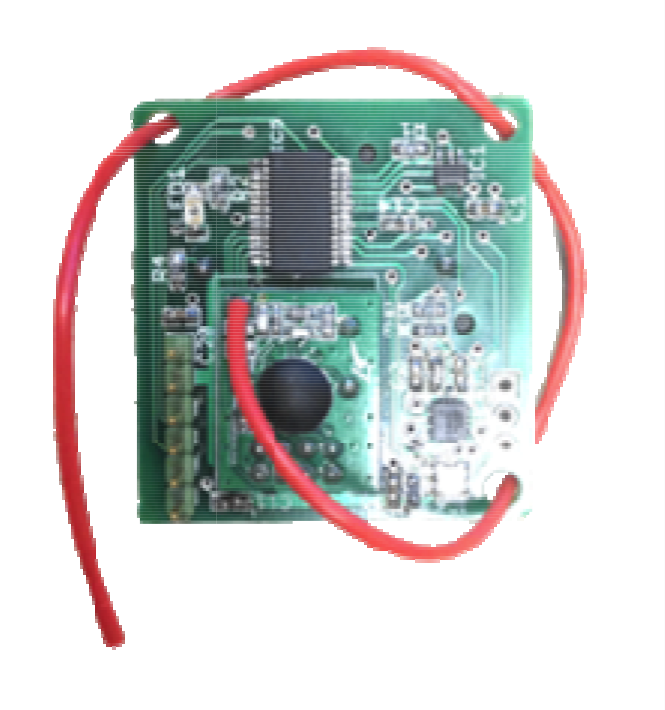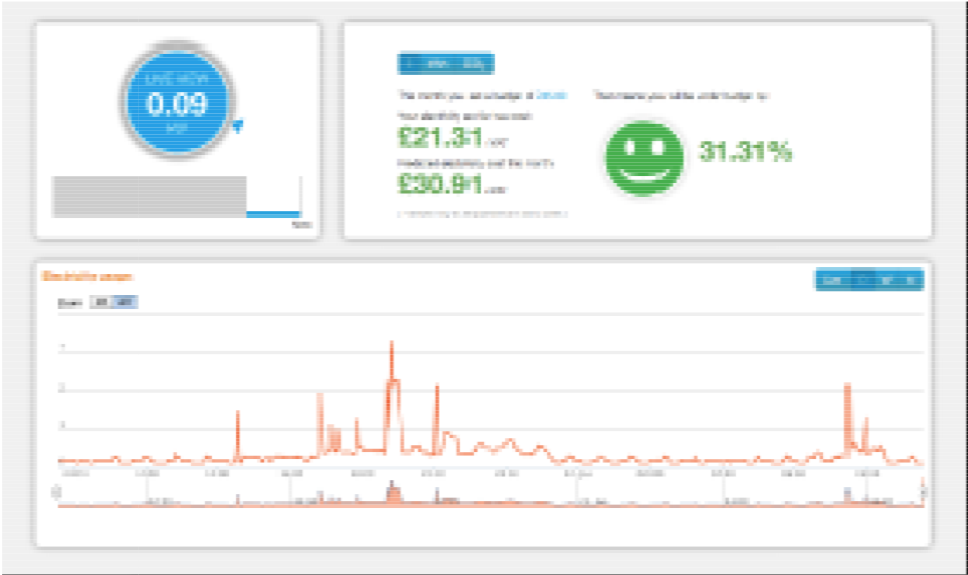Digital Environment Home Energy Management System (DEHEMS)
Submitting Institution
Coventry UniversityUnit of Assessment
Computer Science and InformaticsSummary Impact Type
TechnologicalResearch Subject Area(s)
Information and Computing Sciences: Artificial Intelligence and Image Processing, Computation Theory and Mathematics, Information Systems
Summary of the impact
This case study describes the national and international impact of
research undertaken by
Professor Chao, as part of an EU funded Framework 7 project,
Digital Environment Home Energy
Management Systems (DEHEMS). The project has improved existing household
energy
monitoring, tackling the issues of global warming and CO2
emission reduction in the domestic
sector. The research has directly contributed to the development of a
product called EnergyHive,
subsequently marketed by Small to Medium-sized Enterprise (SME) Hildebrand
Ltd, who was the
industrial partner in the DEHEMS consortium. The research has delivered
the following:
-
Economic impact — as a direct result of the research project,
Hildebrand Ltd has diversified
and entered into an entirely new market;
-
Impact on the environment — home owners, local authorities and
energy companies have
installed EnergyHive meters which have shown significant energy and
carbon dioxide
reductions.
Beneficiaries of the research and the subsequent impact include: a
commercial business,
domestic energy consumers, UK and international energy companies and local
authorities.
Underpinning research
Chao has been at Coventry University since 2000 and the research
that forms the core of this case
study was developed during his time here. Chao's underpinning
research focused originally on
service and semantics modelling, distributed systems, cloud-based
computing and systems
integration [1].
Between June 2008 and July 2011, Chao was a work package leader
within an international
research consortium of 13 industry, local authority and university
partners, from Belgium, Romania,
Bulgaria, and UK, including SME Hildebrand Ltd. The research project,
Digital Environment Home
Energy Management Systems (DEHEMS) (http://www.dehems.eu),
was an EU funded (3.5M
Euros) Framework 7 project. The project's aim was to develop and test a
domestic energy
management system which would improve on the current generation of
monitoring equipment and
deliver carbon dioxide savings across Europe.
DEHEMS built on Chao's existing research expertise in data
modelling and integration. Chao led
the work package developing an ontology of home appliances. The starting
point in developing the
ontology was to study general classifications of home electrical
appliances provided by various
vendors and manufacturers [2]. Although appliance vendors provide energy
efficiency ratings of
home appliances, they do not provide the detailed specification of the
attributes that contribute
towards their overall energy consumption. In the absence of these
attributes and non-existence of
a standard ontology and measurement of users' preferences [4], it is
difficult for reasoning tools to
provide a comprehensive comparison of home appliances based on their
energy consumption
performance. It is also difficult to provide a comparative analysis of
energy consumption of these
appliances and consumers' satisfaction [5]. Thus, the ontology is an
important innovation for the
development of systems to support energy reduction and it has the
potential for wide application in
home energy management.
Based on the ontology, which encodes knowledge of electrical appliances
and their efficiency
together with the association of appliances to households, Chao
then developed an innovative
recommender system based on group decision making method [7], which
provided intelligent
advice on efficient energy consumption to households. It is innovative as
it works on ontology-based
knowledge not previously encoded and also uses knowledge from external
systems. The
recommender system compares energy consumption of similar houses. The
similarity criteria
includes number of family members living in a house and type of houses as
well as other fuzzy
criteria. If a household has consumed more energy than the average of its
similar type of houses
and occupants, the system starts to look for possible causes. The
recommender system also
provides proactive energy consumption advice to households. For example,
on starting the
washing machine, the system checks weather forecast services provided by
Google and generates
advice on drying clothes outside depending on the weather conditions.
The research developed a further innovation in the recommendation [3,6]
as it linked to social
networking sites, through APIs, allowing for community-based interactions.
Energy savers are able
to rate tips and compare progress and the system allows the households to
record their feedback
or experience. Chao also investigated the challenges of capturing
and storing real-time energy
data and developed an innovative method for addressing this challenge in
the form of internet-based
device addressing time-series data capture, and storage in
multi-dimensional data cubes [2,
8] which has greatly influenced the subsequent EU FP7 CASSANDRA project.
References to the research
1. Huang, C-L., Lo, C-C., Chao, K-M., and Younas, M. (2006).
Reaching consensus: A moderated
fuzzy web services discovery method. Information and Software
Technology, 48 (6), 410-423.
(Impact Factor: 1.692; Citations: 18)
2. Shah, N., Tsai, C-F., Marinov, M., Cooper, J., Vitliemov, P., and Chao,
K-M. (2009). Ontological
on-line analytical processing for integrating energy sensor data. IETE
Technical Review 26 (5),
pp. 375-387. (Impact Factor: 0.724; Citations: 5)
3. Chao, K-M., Shah, N., Farmer, R., and Matei, A. (2012). Energy
management system for
domestic electrical appliances. International Journal of Applied
Logistics 3(4): 48-60
4. Lin, W-L., Lo, C-C., Chao, K-M. Younas, M. (2008).
Consumer-centric QoS-aware selection of
web services. Journal of Computer and System Sciences 74(2):
211-231 (Impact = 5-Year
Impact Factor: 1.106; Citations: 18)
5. Lin, W-L., Lo, C-C., Chao, K-M., and Godwin, N. (2011).
Multi-group QoS consensus for web
services. Journal of Computer and System Sciences, 77(2): 223-243.
(Impact Factor: 1.106;
Citations: 5)
6. Wang, P., Chao, K-M., Lo, C-C., and Farmer, R. (2011). An
evidence-based scheme for web
service selection. Information Technology and Management, 12(2):
161-172. (Impact Factor:
3.025; Citations: 12)
7. Wang, P., Chao, K-M., and Lo, C-C. (2010). On optimal decision
for QoS-aware composite
service selection. Expert Systems with Applications, 37 (1),
440-449 (5-Year Impact Factor:
2.339; Citations: 20)
8. Dong, B., Zheng, Q., Tian, R., Chao, K-M., Ma, R., & Anane,
R. (2012). An optimized approach
for storing and accessing small files on cloud storage. Journal of
Network and Computer
Applications, 35(6): 1847-1862 (5-Year Impact Factor: 1.251)
Key Funding:
• Chao and 12 other partners across Europe 3.5M Euros, Digital
Environment Home Energy
Management Systems (DEHEMS) EU Framework 7, 2008-2011, Chao's
element of the funding
0.26M Euros
• Chao and 8 other partners across Europe, A multivariate
platform for assessing the impact of
strategic decisions in electrical power systems (CASSANDRA) 3.4M Euros EU
Framework 7,
2012-2014, Chao's element of the funding 0.30M Euros
Details of the impact
The outcome of Chao's research within the DEHEMS work package fed
directly into the
development of the next generation energy monitoring product and `Software
as a Service' (SaaS)
called EnergyHive. This was subsequently commercialised by Hildebrand Ltd,
the industrial partner
within the DEHEMS consortium. Chao's research led to innovations
in the EnergyHive product,
including: the use of data capture and storage techniques for time series
analytical processing; the
ontology which encodes knowledge of electrical appliances and their
efficiency together with the
association of appliances to households; the recommender system which
provides advice; and the
techniques for social interaction to encourage community efforts. The
research resulted in
diversification into new markets for Hildebrand Ltd, and the development
of the EnergyHive
product and service, delivering environmental impact by reducing
consumersconsumers' energy bills and
carbon footprint.
Impact on the environment
As part of the DEHEMS project Hildebrand Ltd produced the prototype
monitoring devices that
developed into the EnergyHive product and service. The semantic system
developed by Chao is at
the heart of the energy saving functionality of EnergyHive. During the
DEHEMS project the
prototype system was developed in three cycles and incorporated users'
feedback into the
improved system design from each prototype test cycle. The prototype
product, produced by
Hildebrand Ltd, was deployed in 250 households in the UK cities of
Manchester, Birmingham and
Bristol and the Bulgarian cities of Plovdiv and Ivanovo. The results from
this work indicated that
individual homes reduced their energy consumption as a result of the usage
feedback about their
energy consumption. The analysis of energy consumption data collected
before and after
deployment of the prototype system showed an average weekly reduction in
energy consumption
of 7.89%. A survey of the residents that took part in the project showed
that, as a result of
DEHEMS, households had increased their awareness of how their own energy
usage impacts the
environment, as well as the cost of energy consumption.
Chao also developed the recommendation system and ontology, which
automatically and in a
timely manner makes appropriate recommendations for the users to reduce
both energy usage
and CO2 emission. Following the completion of the DEHEMS
project, the EnergyHive product
(shown in Figure 1a, b and c) was developed, enabling users to make
informed decisions to
reduce their energy consumption, thus having a positive impact on the
environment. Camden
Council have installed energy heating and hot water meters in 1000 homes
(using EnergyHive
`Software as a Service' SaaS) and are currently installing it in a further
800 homes during 2013.
The semantic work of Chao is used to display intelligent feedback
on energy usage on tablet
devices. Daniel White, Camden Council, commented that the EnergyHive
product was the most
advanced of its type and Camden Council estimates that over the lifetime
of their heat metering
programme they will save 8,000 tonnes of CO2 within 2500 homes
[b].
 Figure 1a - EnergyHive hub ©Hildebrand Ltd
Figure 1a - EnergyHive hub ©Hildebrand Ltd
 Figure 1b - Energy Elite electricity clamp and transmitter ©Hildebrand Ltd
Figure 1b - Energy Elite electricity clamp and transmitter ©Hildebrand Ltd
 Figure 1c - EnergyHive multi-sensor ©Hildebrand Ltd
Figure 1c - EnergyHive multi-sensor ©Hildebrand Ltd
One of the main aims of the DEHEMS project was to increase both the
awareness and
understanding of the public in relation to their individuaindividual
energy consumption and enable them to
make informed decisions about their future energy usage. General energy
usage has been
reduced by those who viewed their energy usage through the EnergyHive
product [c]. In a survey
(n=183) of initial motivations for saving energy, more than half of the
respondents indicated their
motivation for saving energy was financial. As a result of the DEHEMS
project, the number of
respondents solely interested in financial savings was reduced by 50%. The
number of users
motivated by the environmental impact of their actions increased to 77%
[d]. This evidences the
changes in attitude and behaviour as a result of the research project and
the developed
EnergyHive product. The DEHEMS research impact has been featured in "Big
Ideas for the
Future" report published in 2011 by UK Research Councils [e].
Economic impact
The research has also had significant economic impact for the
consortium's industrial partner,
Hildebrand Ltd [a]. As a result of the research by Chao
and membership of the DEHEMS
consortium Hildebrand Ltd, previously a small R&D company providing
cloud computing products,
has diversified into an entirely new market through the development of the
EnergyHive product to
monitor energy use and provide advice on how to reduce energy consumption.
The simple
interface shown in Figure 2 has been designed to make the EnergyHive
product easy to use and to
understand by consumers, but flexible enough to monitor the whole house
with up to five heat,
motion and other sensors.
 Figure 2 – Screenshot of EnergyHive’s web interface ©Hildebrand Ltd
Figure 2 – Screenshot of EnergyHive’s web interface ©Hildebrand Ltd
Sales of EnergyHive have been to individual consumers, energy companies
for their customers
and local authorities for their tenants. For example, NPower have
purchased 10,000 EnergyHive
licences which they have rolled out to their customers. In addition to
sales within the UK, the
product has been taken up internationally. The housing authorities in
Australia are projecting to
reduce energy consumption for their tenants by 20% by using the product.
Since 2011, EnergyHive
products have generated income to Hildebrand Ltd of £7,509,5000. This is
made up of 2000 units
of EnergyHive Home to individuals, 6500 EnergyHive `Software as a Service'
(SaaS) licences and
one EnergyHive Enterprise licence.
In addition, to the development of EnergyHive, Chao's research
also transferred to Hildebrand the
necessary knowledge to enable them to work with IBM to develop and market
the Hildebrand
database acceleration product with ontology, which improves efficient
time-series analytical
processing for big data.
Conclusion
This case study demonstrates that Chao's research had economic
impact and as a direct result
Hildebrand Ltd has diversified and entered into entirely new profitable
markets. In addition, the
research has an impact on the environment by creating the core
technology for EnergyHive
meters which enable home owners, local authorities and energy companies'
significant energy and
carbon dioxide reductions by smart monitoring and advising on energy use.
Sources to corroborate the impact
a. Chief Executive Officer, Hildebrand Ltd, (information collected by
RAND in an interview — see
report PR-546-CU) and additional testimonial.
b. Mr Daniel White, Senior Energy and Sustainability Officer, Camden
Council, RAND report PR-546-CU
c. DEHEMS Final Report http://tinyurl.com/ojz38m6
d. DEHEMS D7.7: Project Cycle Analysis Report for Cycle 3 http://tinyurl.com/qjpleut
e. http://www.rcuk.ac.uk/documents/publications/BigIdeasfortheFuturereport.pdf